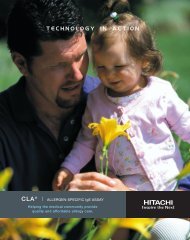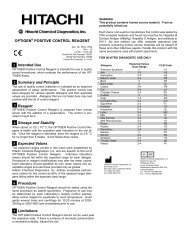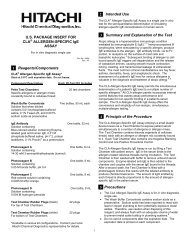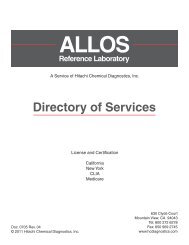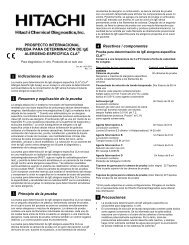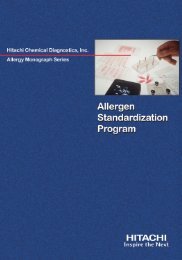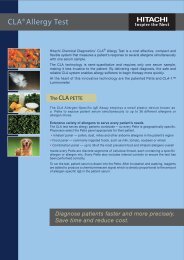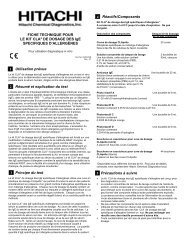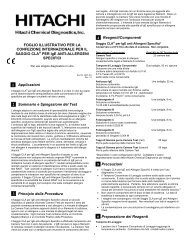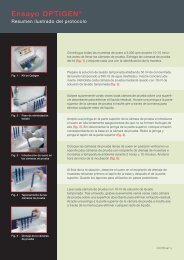Allergen Resource Guide - Hitachi Chemical Diagnostics
Allergen Resource Guide - Hitachi Chemical Diagnostics
Allergen Resource Guide - Hitachi Chemical Diagnostics
Create successful ePaper yourself
Turn your PDF publications into a flip-book with our unique Google optimized e-Paper software.
<strong>Resource</strong> <strong>Guide</strong> to the Most Common <strong>Allergen</strong>s<br />
Common Name: Short Ragweed<br />
Latin Name: Ambrosia elatior<br />
NCCLS Code: W1<br />
Description: Short Ragweed, a weed pollen allergen, are homely wildflowers. Among<br />
all pollen allergens, including trees and grasses, ragweed pollen affects<br />
the most people. Common symptoms include rhinoconjunctivitis, sneezing,<br />
red and itchy eyes, and running nose.<br />
<strong>Allergen</strong>ic Proteins (with molecular weight): *<br />
Amb a 1, Amb a 4, Amb a 5, Amb a 3<br />
In-House Clinical Evaluation Results:<br />
Sensitivity: 100% Specificity: 89%<br />
Efficiency: 97% Number of Samples: 31<br />
*Look above for a complete list of allergens<br />
Common Name: Giant Ragweed<br />
Latin Name: Ambrosia trifida<br />
NCCLS Code: W3<br />
Description: Giant Ragweed, a weed pollen allergen, blooms in mid-August and lasts<br />
until October. Symptoms include sneezing, red and itchy eyes, sore<br />
throat and running nose.<br />
<strong>Allergen</strong>ic Proteins (with molecular weight):<br />
Amb t 5 (Ra5G at 4.4 kDa).<br />
In-House Clinical Evaluation Results:<br />
Sensitivity: 100% Specificity: 100%<br />
Efficiency: 100% Number of Samples: 31<br />
Common Name: Mugwort<br />
Latin Name: Artemisia vulgaris<br />
NCCLS Code: W6<br />
Description: Mugwort, a tall plant or weed, is found in damp environments in many<br />
parts of the world. It was commonly used to flavor beer before the<br />
introduction of hops.<br />
<strong>Allergen</strong>ic Proteins (with molecular weight):<br />
12 kDa, 17 kDa, 20 kDa (Art 7 (Does not bind IgE after transfer)), 22 kDa,<br />
Art v 1 27-29 kDa, Art v 2 at 35 kDa, 39 kDa, 42, kDa<br />
In-House Clinical Evaluation Results:<br />
Sensitivity: 100% Specificity: 100%<br />
Efficiency: 100% Number of Samples: 28<br />
23



